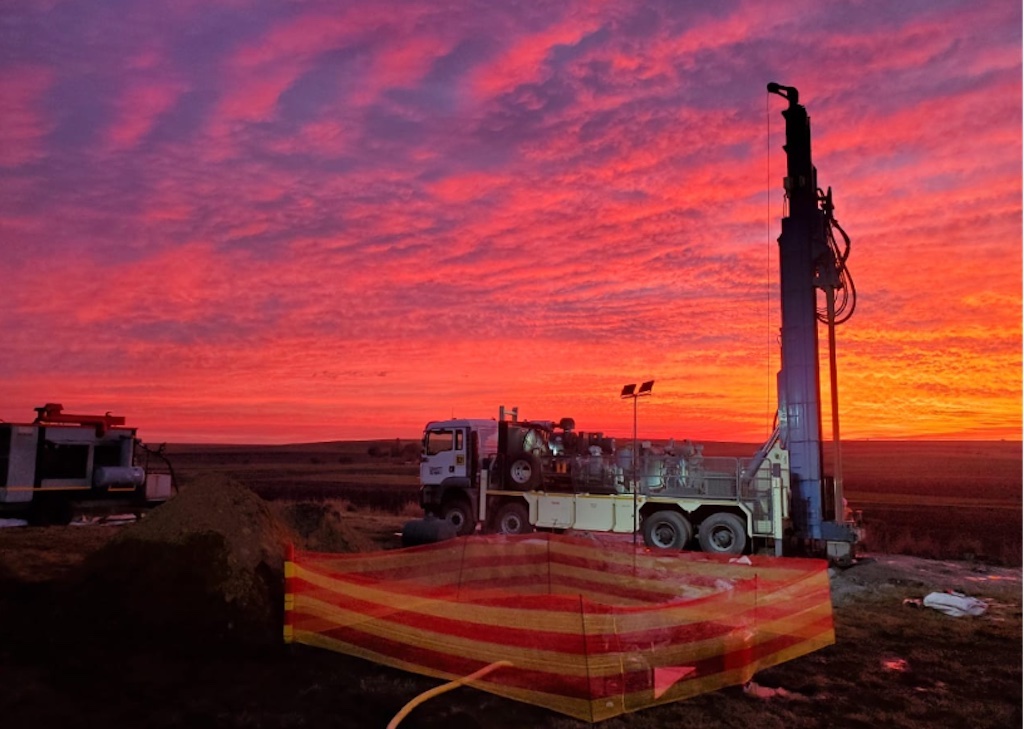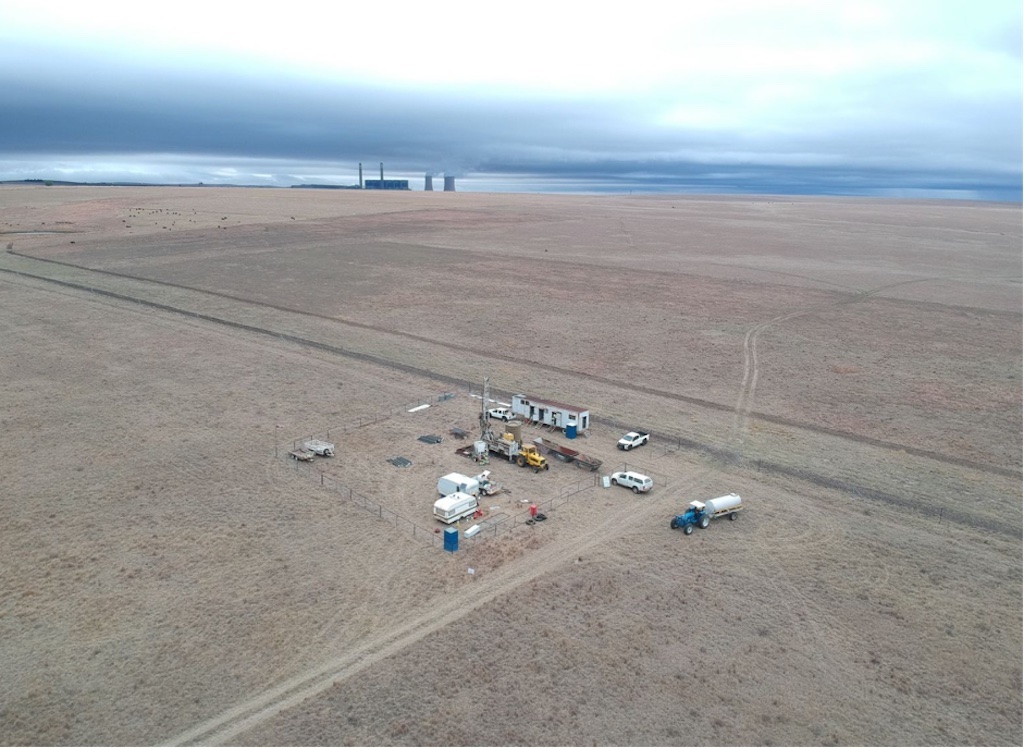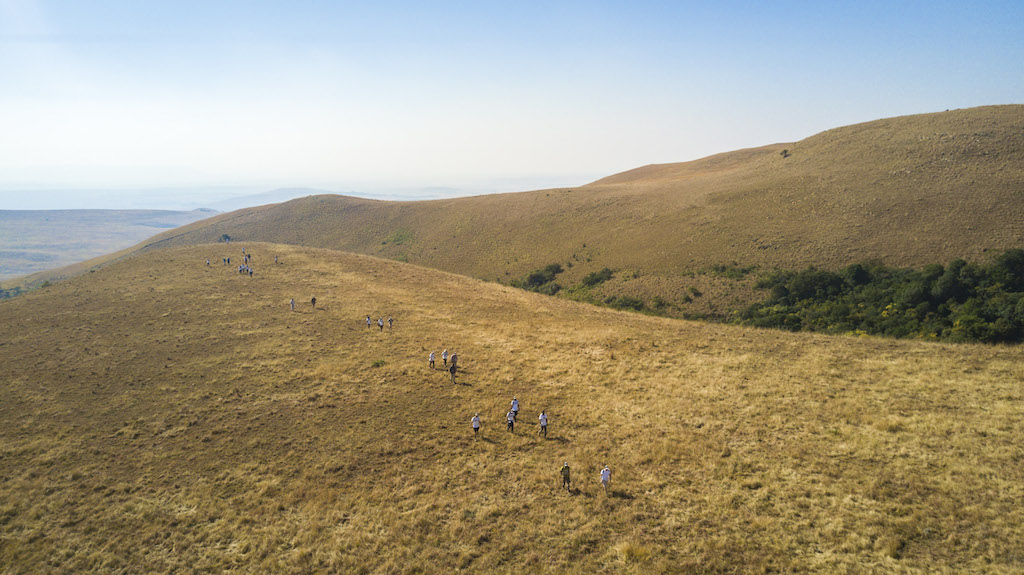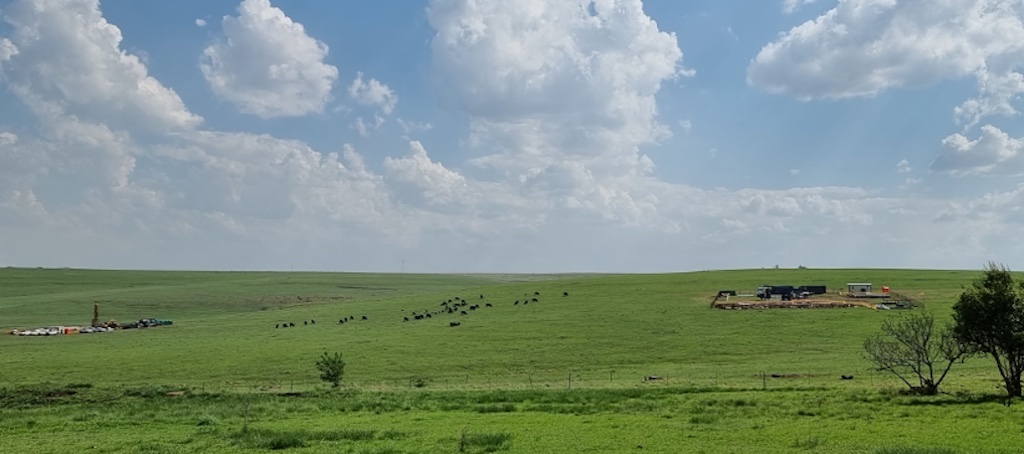
23 Feb Mpumalanga gas project aims to bridge JET gap
Development of R155-million LNG pilot in Amersfoort promoted as a way to alleviate energy shortages while South Africa transitions to renewable energy. Thabo Molelekwa investigates

A core hole drilling site at dawn. Kinetiko describes the Amersfoort project as South Africa’s largest onshore LNG project. Photo supplied
The development of natural gas reserves in Amersfoort, a small town in Mpumalanga, is being punted as having the potential to reshape South Africa’s energy dynamics and play a pivotal role in the nation’s journey toward a more diversified and sustainable energy future.
However, environmental organisations question whether gas is a green energy source, and whether it will contribute to South Africa’s undertakings in the global fight against climate change.
In 2023 Kinetiko Energy, an Australian gas exploration company, and the Industrial Corporation of South Africa (IDC) jointly signed a liquefied natural gas (LNG) development project for Amersfoort. The town is situated near Volksrust in the Mpumalanga-KwaZulu-Natal provincial border area, the heart of the country’s energy capital.
Kinetiko describes the project, codenamed Korhaan after an endemic bird species found in the area, as South Africa’s largest onshore LNG project and aims to produce 50 megawatts (MW) of equivalent energy initially, with plans to expand to 500MW through the abstraction of more than two trillion cubic feet in gas reserves. LNG is natural gas that has been cooled down to liquid form for ease and safety of non-pressurised storage or transport.
IDC funding
Tshepo Ramodibe, head of IDC Corporate Affairs, told Oxpeckers the discovery of the Amersfoort gas reserves followed more than two decades of extensive exploration and drilling conducted by various entities. The Korhaan project is still in the development phase, he said, with confirmatory drilling work and the completion of the application for production rights under way.
“IDC will provide development funding for the project to complete a pilot phase that should confirm the availability of the gas reserves,” explained Ramodibe. The budget for the pilot phase is R155-million, with IDC committing up to R70-million for this phase, while the balance is provided by Afro Energy, a subsidiary of Kinetiko Energy Ltd.
Asked what factors make Mpumalanga an attractive location for onshore LNG investment, Ramodibe identified the project’s proximity to local markets, especially Sasol, and the potential for power stations in the province to be converted to gas.
“Various companies are on record exploring potential gas reserves in Mpumalanga. However, confirmations and outcomes can only be made by the involved companies,” he said.
South Africa’s other onshore LNG project, the Renergen project, comprises exploration and production rights of 187,000ha of gas fields across Welkom, Virginia and Theunissen, in the Free State province. Full production is expected by 2027.

A temporary core hole site near to a coal-fired power station. The IDC has identified the potential for power stations in Mpumalanga to be converted to gas. Photo supplied
Transition fuel
Acknowledging that gas is not a renewable resource, Ramodibe said: “It is a resource that has the potential to alleviate the energy shortage in South Africa while the country transitions to renewable energy.”
Makhosonke Buthelezi, spokesperson for the Department of Mineral Resources and Energy, affirmed that natural gas forms part of South Africa’s energy mix, as outlined in the Integrated Resource Plan (IRP 2019). He told Oxpeckers that gas is a global transition fuel, providing the flexibility necessary for cost-effective electricity generation.
“In this regard, the DMRE promotes exploration and production of gas and supports the development of gas infrastructure to augment the country’s electricity generation capacity,” Buthelezi said, highlighting gas as a crucial resource for baseload energy, strengthening South Africa’s energy security and supporting sustainable industrialisation.
However, lawyers at the Centre for Environmental Rights (CER) cautioned against the development of large-scale gas-to-power infrastructure development in South Africa, citing potential negative impacts on decarbonisation efforts and climate risks.
“Every country’s profile in this regard will be different, depending on their resources and existing infrastructure. Every country, however, needs to move as quickly as possible towards clean, low-carbon energy provision and electricity generation,” the CER lawyers said in an interview with Oxpeckers.
“In South Africa, we need to move away from coal as quickly as possible as we build renewable energy capacity. Of course, this cannot be done immediately, and the existing functioning coal fleet should be retrofitted with pollution abatement as one mitigation measure. This existing fleet will provide the generation needed to supplement the renewables as they get built and come online,” CER told Oxpeckers.
According to CER, as renewable energy can be intermittent – for example, when solar or wind resources are limited – there is sometimes a need for any shortfall to be made up by “peaking” generation sources, such as that currently provided by diesel turbines. The organisation said some models suggest that, from a technological point of view, this peaking could be gas-fired.

Nick de Blocq: The Kinetiko CEO agreed with the recent European Union classification of gas as ‘green’. Photo supplied
Renewables challenges
Nick de Blocq, chief executive officer of Kinetiko Energy, expressed doubt about whether renewables can replace coal in South Africa. He emphasised the need for the urgent pursuit of nuclear and gas power at scale, and pointed to Europe’s challenges in transitioning directly to renewables.
The cleanest energy solutions we have available today globally include geothermal, hydro, nuclear and gas. In South Africa, at scale, that means nuclear and gas should be pursued with urgency. We cannot pin our hopes for regional-level power on things we cannot have,” De Blocq said.
According to him, the global average output from weather-related energy sources is in the region of 25% of installed capacity, quite often dropping into single figures.
“The outcome in Europe from an attempt to transition directly to renewables has resulted in the least available and most expensive electrical power bills in the history of the continent,” he added. “They are reverting to coal and diesel to fill the gap so glaringly left by ‘renewables’, which are by no means clean and green energy.”
De Blocq acknowledged that gas is not renewable but agreed with the recent European Union classification of gas as “green”. Though not cheaper than coal, gas is substantially cleaner, greener and offers a more efficient burn, he said.
He highlighted Mpumalanga’s strategic location for gas, and South Africa’s current need to import gas due to limited LNG production in the country. “South Africa needs to evolve from being a 100% gas importer to accommodate domestic supply from both offshore and onshore,” he said.

Landowners and farmers in the agricultural belt ‘are not the owners of the gas under their feet – it is owned 100% by the state’, said De Blocq. Photo © Johnny Miller
Affected communities
Asked whether communities affected by the project were consulted, De Blocq told Oxpeckers, “We are obligated to communicate with stakeholders and landowners to share our plans with them, at the various stages of applications for exploration rights and production rights. We went through that process some time ago… and we will meet once again with them as we evolve into producers in the future. Landowners and farmers need to understand clearly that we represent a net benefit to them.”
Unlike solar farms, which take inordinate land space as they provide intermittent power, he said, gas production will be from small boreholes in the ground every 400m or so, “and therefore of negligible disturbance to agriculture”.
“And although landowners are not the owners of the gas under their feet – it is owned 100% by the state – as the rights holder we believe that the landowner should benefit from what we do in the form of a cash consideration for our access, as well as in the provision of paid-for services like accommodation, plant hire, road-building and more,” De Blocq added.

Cattle graze in between two gas borehole sites. Kinetiko says production for the project will be from small boreholes in the ground every 400m or so. Photo supplied
Promising step
Njock Ayuk Eyong, chief executive of the African Energy Chamber, praised the Amersfoort project as “a promising step on the long road to Africa’s just energy transition” in a recent opinion editorial.
He emphasised the significance of gas as the way forward for African states, and asked where the money would come from for building wind and solar farms infrastructure if the continent was unable to profit from its own natural resources, “natural gas being the most vital among them”.
“We are told to play this game of catch-up with our hands tied: to leave our natural resources in the ground while the developed nations of the world continue to exploit their natural non-renewable wealth. We are expected to jump straight to building wind farms, solar farms and hydroelectric dams while hundreds of millions of Africans are still living without access to electricity,” he wrote.
“Who will build the foundational infrastructure needed to support it? Developed nations are quick to promise, ‘We will’ but reticent to follow through on their promises. What’s more, their foreign ‘aid’ has frequently focused more on alleviating the symptoms of Africa’s economic and energy poverty rather than resolving the source.”
Oxpeckers reached out to African Energy Chamber for further comments on the LNG project in Amersfoort, but it had not responded by the time of publishing.
Thabo Molelekwa is an associate journalist of Oxpeckers Investigative Environmental Journalism, and a graduate of our #PowerTracker professional support and training programme. This investigation was supported by the African Climate Foundation’s New Economy Hub
• You can track the development of energy projects across Mpumalanga province on the Oxpeckers #PowerTracker tool
